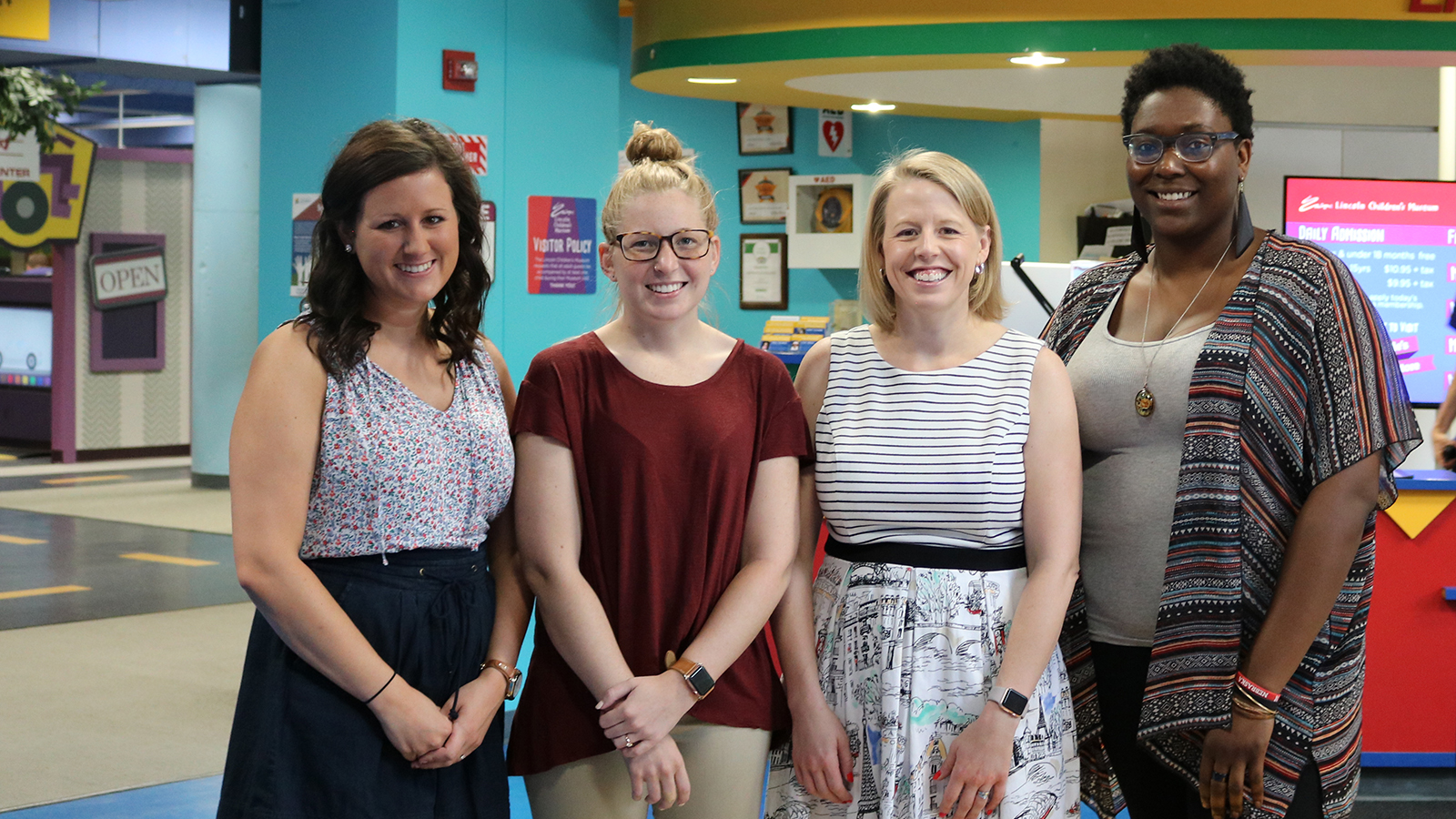
Emily Dorsey and School Psychology grad students team up to create social story for Lincoln Children’s Museum
17 Dec 2018 By Kelcey Buck
The Lincoln Children’s Museum recently unveiled on its website a new tool intended to make the museum more accessible for all children who wish to visit – a social story. The story is the result of several weeks of collaboration by Emily Dorsey, an assistant professor of practice in the University of Nebraska-Lincoln’s Department of Special Education and Communication Disorders, and Micheale Marcus, Katie Mosher, Rachel Schumacher, and the late Alicia Kruger, all students in Nebraska’s School Psychology graduate program.
A social story is a narrative that explains how a person should act in a particular situation. These stories, which are written in first-person, are often used by people with autism to help prepare them for settings which may otherwise be uncomfortable.
“The big goal is to make the museum something that’s accessible to more people than it would have been otherwise,” Dorsey explained. “This is intended to be a tool so that people who might avoid it or might have trouble with it can learn about it beforehand, know what to do and feel more confident going there.”
Lindsay Bartlett, director of community & learning at the Lincoln Children’s Museum, said that in the midst of ongoing discussions about making the museum as inclusive as possible, and while preparing to host a sensory night sponsored by the Center for Autism and Related Disorders, a program coordinator in the museum’s education department found other museums who had social stories available. When Lizzie Chelle-Andersen, who has experience as a K-12 resource teacher, suggested the Lincoln Children’s Museum should find a way to create its own social story, Bartlett immediately contacted the university for help in making it a reality.
“Working with the university is such an obvious choice for us,” Bartlett said. “We have many volunteers who are students and several faculty members have ongoing research projects with us. Reaching out to the university for this project was a natural expansion of our current partnership, one that we hope continues to grow.”
After Bartlett’s initial contact, Dorsey responded that she’d be interested in helping with the social story but would like to also include a few students. Bartlett was on board with that idea. Dorsey met with the students to begin planning their process for creating the social story. Marcus, who is currently on internship with Lincoln Public Schools and planning to pursue her Board-Certified Behavior Analyst (BCBA) credential, took the lead on the project, making sure responsibilities were divided up in a way that ensured all exhibits were included and the story flowed smoothly throughout.
“We wanted to create a resource parents and caregivers could use with their children diagnosed with Autism Spectrum Disorder (ASD) before visiting the museum,” Marcus said. “This social story allows these children, who may be initially overwhelmed by all the exhibits, to be gradually exposed to them so they are prepared when they visit the museum. The social story also provides examples of appropriate play-based activities for each exhibit, in addition to staying safe and playing with peers in the museum.”
After an initial visit to the museum where the group met with Bartlett and began taking photos and gathering information about the exhibits, the group returned for a couple follow-up visits to capture any photos or information they were missing. The final product is a 43-page PDF that can be viewed on the Lincoln Children’s Museum’s website. The first section describes what to do when you arrive at the museum, how to identify museum staff, and locations for quiet rooms, restrooms and snacks. The other three sections describe the exhibits on each of the museum’s three floors – Main, Upper and Lower.
“This project is the result of excellent teamwork,” Schumacher said. “It was a good reminder of the things that most people take for granted on a daily basis. It can be harder than you think to really break down something most people find so common into smaller steps and to anticipate what may be challenging for a child with autism.”
For the students, the project proved to be both a learning experience and a rewarding way to help the community.
“I work with young children with autism, but I appreciate how this project has allowed me to take an experience such as going to the Lincoln Children’s Museum and explore it from the perspective of a family of a child with autism,” Mosher said. “It was a great learning experience taking the background knowledge we had as a team about autism and applying that to a new situation to look at each exhibit and determine what would be the most helpful for children with autism to know about each space.”
Dorsey said that while she has written many social stories in her career, creating this one for the Lincoln Children’s Museum helped her realize she could possibly be on the lookout for other places in the community that might benefit from a similar project. She hopes the students have had the same shift in their thinking as well.
“These are graduate students and we usually think of people with advanced degrees as leaders in their field. This is a great experience for them to do now because they can do this wherever they live or work later.”
Overall, the hope is that this new social story will open up the possibility of visiting the museum to more children and families.
“It’s our goal that all families and children feel welcome and have a positive experience at the museum,” Bartlett said. “While many children (and caregivers) find the informal learning environment of the museum a positive, for some it’s a major stressor. If this social story and website enhancement helps just one family have a more positive experience here, then it was well worth the effort.”
Special Education and Communication Disorders